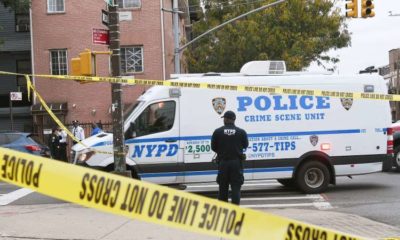World
Snowstorm wreaks havoc in US northeast coast

Washington: The snowstorm that started Monday evening across the US northeast coast continued to ravage the region Tuesday, with millions of people living in New York City, Boston, Philadelphia and other metropolises in the area being affected.
The snowstorm continued to smack eastern Long Island in the state of New York, as well as states of Connecticut, Rhode Island and Massachusetts Tuesday noon, Xinhua reported.
According to US National Weather Service forecasters, the tough weather is expected to continue into early Wednesday morning in Boston and Massachusetts, which has already received about 50 cm of snowfall.
But meteorologists in the country apologised Tuesday morning after the so-called “Storm of the Century” proved to be less destructive than predicted.
Blizzard warnings that called for up to about 91.44 cm, to fall in New York City led officials to close schools, cancel flights and institute a statewide travel ban. But the snowstorm did not pummel parts of New York, New Jersey and Pennsylvania with the same punch that forecasters had predicted.
In New York City, only about 15.24 cm of snow fell at the famed Central Park by early Tuesday, far less than the record snowfall of 68.33 cm in 2006.
Governors of New York, New Jersey and Connecticut lifted travel bans they had imposed a day earlier and New York City’s subway system resumed service after being closed for 10 hours, but officials urged people to stay off snow-covered roadways.
In Boston, the subways would remain closed for at least the rest of the day since there is still heavy snow piled in some places of the city.
Police reported that high tides breached a seawall in Marshfield, Massachusetts, about 50 km south of Boston. The police have urged residents of the area to evacuate before the next high tide, expected later Tuesday.
Outside Boston, the heaviest snowfall of more than 70 cm has recorded in Auburn and Framingham, also in Massachusetts, leaving a lot of homes and businesses without power.
In addition, more than 4,700 scheduled flights in the country were cancelled Tuesday, according to FlightAware.com, with more than 80 percent of the cancelled flights occurring at airports in Greater New York City Area, Philadelphia and Boston.
World
Lockdowns in China Force Urban Communities to Defy Censorship and Vent Frustration Online

Shanghai’s rich middle class is leading a wave of online dissent over the strict and prolonged lockdowns imposed in various parts of the country. Chinese internet censorship is struggling as patience is wearing thin in many urban centers, coming up with creative forms of online protests.
Social Media Posts Revealing Lockdown Tension in Shanghai
Drawn-out lockdowns are nothing new in China as authorities insist with the nation’s zero-Covid policy since the start of the pandemic. Currently over This time around, however, metropolitan areas like Shanghai are increasingly difficult to keep quiet, given that its more than 25 million residents have seen weeks of total isolation along with food shortages and many other service interruptions.
Dozens of towns and reportedly over 300 million Chinese citizens have been affected by lockdowns of different severity. As expected, urban netizens have been most outspoken over their difficulties by finding creative ways to get around state censorship and bans placed on topics, news comments and spontaneous campaigns.
Shanghai residents have been using mobile proxies and hijacking seemingly unrelated hashtags to talk about healthcare issues, delivery failures and the overall severity of their situation. The “positive energy” that the Chinese government wants to transmit during the recent prolonged series of lockdowns does not come naturally to those counting food supplies and online censors are working hard to filter words, trending topics and undesired social media sharing.
WeChat groups and message threads are under constant monitoring. Posts questioning the zero-Covid approach have been quickly deleted, including by leading Chinese health experts like Dr. Zhong Nanshan. Video footage is soon censored and protests and investigations are quickly made to disappear.
Where this has not worked, officials have exposed banners with warnings and outright threats like “watch your own mouth or face punishment”, while drones have been patrolling the city skies. Yet, if anything, this has led to further tensions and unspoken confrontation with Shanghai’s educated and affluent middle class.
Creative Online Solutions Harnessing Civic Energy
Announcements by Chinese social media that they would be publishing the IP addresses of users who “spread rumors” have not helped either. Tech industry research has shown that much of Asia’s tech-savvy population has a habit of using mobile proxies and other privacy tools, quickly finding workarounds to browse the internet freely and talk to the world about the hottest topics.
The sheer volume of forbidden posts is already a challenge for the very censorship system, experts explain. Unable to track all trending hashtags, state workers overlook topics that speak about the US, Ukraine or other popular news. Linking human rights elsewhere to their situation, Chinese online dissidents establish their informal channels and “hijack” the conversation to share personal or publicly relevant information about the Covid suppression in their town.
Sarcastic and satirical posts still dominate. Others hope to evade the censors by replacing words from famous poems or the national anthem. One thing is certain – social media, when harnessed with the right creativity, has proven its ability to mount pressure on the government in even some of the most strictly controlled tech environments like China.























